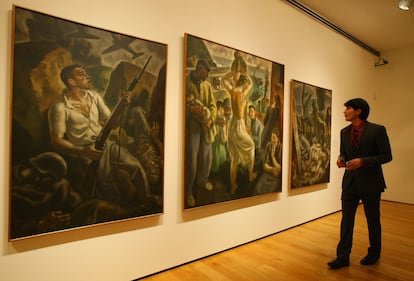Mystery tax defaulter settles millions of euros in debt by handing in 200 Goya artworks
The art was worth $4.3 million, but even that was not enough to cover the entire owed amount, said authorities in Spain’s Basque Country. In another plot twist, the paintings and engravings theoretically belonged to a private art foundation


Someone with a very powerful estate and whose identity remains a secret has settled a tax debt worth millions of euros with authorities in Álava, in Spain’s Basque Country. And this individual partly did so by donating more than 200 engravings by Francisco de Goya as well as 87 other works of art — among them, Aurelio Arteta’s outstanding anti-war manifesto Triptych of War, which has been compared with Picasso’s Guernica and was completed just a year later, in 1937. All this art, which was valued at €4.3 million, came from the collection of a private institution, the Juan Celaya Letamendia Foundation.
The provincial authority of Álava has confirmed that the rest of the owed amount — it did not provide a specific figure — was paid for with a money transfer. It also noted that just receiving Arteta’s masterpiece “in itself justifies” the operation, according to the head of the culture department of Álava province, Ana del Val.
Payment in kind to cancel a tax debt is accepted by public treasuries in Spain. In the case of the Basque province of Álava, the system has been used on 20 occasions since 2001, and on seven of these it was done through artworks, the head of the Álava treasury, Itziar Gonzalo, explained in June at a public parliamentary appearance. But never before had it involved such a high amount of money.
The uniqueness of the case begs the question: what is the total fortune of a person who has accumulated a wealth tax debt of more than €4 million ($4.28 million)? And there are other question marks, such as how can an individual settle a personal tax debt by handing in works of art that supposedly belong to a private foundation?
The artworks belonged to an institution named after Juan Celaya, a Basque entrepreneur who died in 2016 and who was known for his ties to the battery manufacturer Cegasa and Solac appliances; he was also a patron of Basque culture and sports. In 2018, this foundation signed an agreement with Álava provincial authorities that included the transfer of artworks to the Museum of Fine Arts of Álava for a period of four years, extendable to more. The collection, valued by insurers at €2.3 million ($2.46 million), was made up of paintings by renowned local authors, and also included several engravings by Francisco de Goya.
All of this artistic material and several other works of great cultural value are now in the hands of the provincial authorities after being delivered as payment by a delinquent taxpayer. Nobody knows this person’s identity. The provincial treasury refuses to reveal the name, citing privacy laws. The sources consulted by this newspaper were adamant that the foundation itself did not have any outstanding tax debt. The foundation’s cultural advisor, Gorka Basterretxea, told the media that he did not know how a collection belonging to a foundation has been transferred to an individual, who has then immediately delivered it to the provincial treasury to settle his or her tax debt.
“It is a set of artistic assets of great value due to their quality, and which we would not have been able to acquire otherwise,” says Del Val on behalf of the Álava institution. “It is now no longer in private hands, but will be put up for the enjoyment of all.”
Sign up for our weekly newsletter to get more English-language news coverage from EL PAÍS USA Edition
Tu suscripción se está usando en otro dispositivo
¿Quieres añadir otro usuario a tu suscripción?
Si continúas leyendo en este dispositivo, no se podrá leer en el otro.
FlechaTu suscripción se está usando en otro dispositivo y solo puedes acceder a EL PAÍS desde un dispositivo a la vez.
Si quieres compartir tu cuenta, cambia tu suscripción a la modalidad Premium, así podrás añadir otro usuario. Cada uno accederá con su propia cuenta de email, lo que os permitirá personalizar vuestra experiencia en EL PAÍS.
¿Tienes una suscripción de empresa? Accede aquí para contratar más cuentas.
En el caso de no saber quién está usando tu cuenta, te recomendamos cambiar tu contraseña aquí.
Si decides continuar compartiendo tu cuenta, este mensaje se mostrará en tu dispositivo y en el de la otra persona que está usando tu cuenta de forma indefinida, afectando a tu experiencia de lectura. Puedes consultar aquí los términos y condiciones de la suscripción digital.
More information
Archived In
Últimas noticias
Most viewed
- Sinaloa Cartel war is taking its toll on Los Chapitos
- Reinhard Genzel, Nobel laureate in physics: ‘One-minute videos will never give you the truth’
- Oona Chaplin: ‘I told James Cameron that I was living in a treehouse and starting a permaculture project with a friend’
- Why the price of coffee has skyrocketed: from Brazilian plantations to specialty coffee houses
- David King, chemist: ‘There are scientists studying how to cool the planet; nobody should stop these experiments from happening’










































